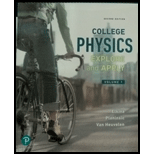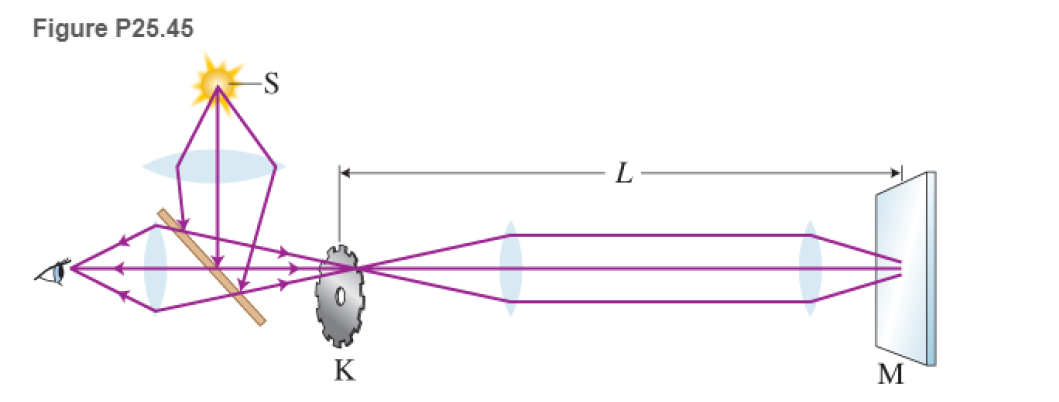
COLLEGE PHYSICS:VOL.1
2nd Edition
ISBN: 9780134862897
Author: ETKINA
Publisher: PEARSON
expand_more
expand_more
format_list_bulleted
Textbook Question
Chapter 25, Problem 46GP
&

Expert Solution & Answer
Want to see the full answer?
Check out a sample textbook solution
Students have asked these similar questions
For each of the actions depicted below, a magnet and/or metal loop moves with velocity v→ (v→ is constant and has the same magnitude in all parts). Determine whether a current is induced in the metal loop. If so, indicate the direction of the current in the loop, either clockwise or counterclockwise when seen from the right of the loop. The axis of the magnet is lined up with the center of the loop. For the action depicted in (Figure 5), indicate the direction of the induced current in the loop (clockwise, counterclockwise or zero, when seen from the right of the loop). I know that the current is clockwise, I just dont understand why. Please fully explain why it's clockwise, Thank you
A planar double pendulum consists of two point masses \[m_1 = 1.00~\mathrm{kg}, \qquad m_2 = 1.00~\mathrm{kg}\]connected by massless, rigid rods of lengths \[L_1 = 1.00~\mathrm{m}, \qquad L_2 = 1.20~\mathrm{m}.\]The upper rod is hinged to a fixed pivot; gravity acts vertically downward with\[g = 9.81~\mathrm{m\,s^{-2}}.\]Define the generalized coordinates \(\theta_1,\theta_2\) as the angles each rod makes with thedownward vertical (positive anticlockwise, measured in radians unless stated otherwise).At \(t=0\) the system is released from rest with \[\theta_1(0)=120^{\circ}, \qquad\theta_2(0)=-10^{\circ}, \qquad\dot{\theta}_1(0)=\dot{\theta}_2(0)=0 .\]Using the exact nonlinear equations of motion (no small-angle or planar-pendulumapproximations) and assuming the rods never stretch or slip, determine the angle\(\theta_2\) at the instant\[t = 10.0~\mathrm{s}.\]Give the result in degrees, in the interval \((-180^{\circ},180^{\circ}]\).
What are the expected readings of the ammeter and voltmeter for the circuit in the figure below? (R = 5.60 Ω, ΔV = 6.30 V)
ammeter
I =
Chapter 25 Solutions
COLLEGE PHYSICS:VOL.1
Ch. 25 - Review Question 25.1 What is the difference...Ch. 25 - Review Question 25.2 What needs to happen to...Ch. 25 - Review Question 25.3 How are GPS and radar...Ch. 25 - Review Question 25.4 If the frequency of one...Ch. 25 - Review Question 25.5 Electromagnetic waves are...Ch. 25 - Review Question 25.6 Explain why polarizing...Ch. 25 - Multiple Choice Questions The fact that light can...Ch. 25 - Multiple Choice Questions What does a beam of...Ch. 25 - Multiple Choice Questions What does Faraday's law...Ch. 25 - Multiple Choice Questions
4. Maxwell's hypothesis...
Ch. 25 - Multiple Choice Questions What does a simple...Ch. 25 - Multiple Choice Questions An electrically charged...Ch. 25 - Prob. 7MCQCh. 25 - Multiple Choice Questions If the amplitude of an E...Ch. 25 - Multiple Choice Questions
9. You notice that...Ch. 25 - Multiple Choice Questions You have two green...Ch. 25 - Prob. 11CQCh. 25 - Conceptual Questions What are two models that...Ch. 25 - Conceptual Questions
13. Summarize Maxwell's...Ch. 25 - Conceptual Questions What testable predictions...Ch. 25 - Conceptual Questions
15. Describe the conditions...Ch. 25 - Conceptual questions
16. Explain how radar works...Ch. 25 - Conceptual Questions
17. What determines the...Ch. 25 - Conceptual Questions How was the hypothesis that...Ch. 25 - Conceptual Questions
19. What is the difference...Ch. 25 - Conceptual Questions
20. How do polarized glasses...Ch. 25 - Conceptual Questions You bought a pair of glasses...Ch. 25 - Conceptual Questions Why. when we use polarized...Ch. 25 - Conceptual Questions 23 How does a polarizer for...Ch. 25 - Conceptual Questions
24. What is an LCD and how...Ch. 25 - Prob. 25CQCh. 25 - 25.1 and 25.2 Polarization of waves and Discovery...Ch. 25 - 25.1 and 25.2 Polarization of waves and Discovery...Ch. 25 - 25.1 and 25.2 Polarization of waves and Discovery...Ch. 25 - 25.1 and 25.2 Polarization of waves and Discovery...Ch. 25 - 25.1 and 25.2 Polarization of waves and Discovery...Ch. 25 - 25.1 and 25.2 Polarization of waves and Discovery...Ch. 25 - 25.1 and 25.2 Polarization of waves and Discovery...Ch. 25 - Prob. 8PCh. 25 - 25.1 and 25.2 Polarization of waves and Discovery...Ch. 25 - 25.1 and 25.2 Polarization of waves and Discovery...Ch. 25 - 25.3 Applications of electromagnetic waves 11 EST...Ch. 25 - 25.3 Applications of electromagnetic waves
12.*...Ch. 25 - 25.3 Applications of electromagnetic waves
13. *...Ch. 25 - 25.3 Applications of electromagnetic waves *...Ch. 25 - 25.3 Applications of electromagnetic waves * TV...Ch. 25 - 25.3 Applications of electromagnetic waves **...Ch. 25 - 25.4 and 25.5 Frequency, wavelength, and the...Ch. 25 - Prob. 18PCh. 25 - 25.4 and 25.5 Frequency, wavelength, and the...Ch. 25 - 25.4 and 25.5 Frequency, wavelength, and the...Ch. 25 - 25.4 and 25.5 Frequency, wavelength, and the...Ch. 25 - 25.4 and 25.5 Frequency, wavelength, and the...Ch. 25 - 25.4 and 25.5 Frequency, wavelength, and the...Ch. 25 - 25.4 and 25.5 Frequency, wavelength, and the...Ch. 25 - Prob. 25PCh. 25 - 25.4 and 25.5 Frequency, wavelength, and the...Ch. 25 - 25.4 and 25.5 Frequency, wavelength, and the...Ch. 25 - Prob. 29PCh. 25 - 25.6 Polarization and light reflection
33. * An...Ch. 25 - 25.6 Polarization and light reflection * BIO...Ch. 25 - 25.6 Polarization and light reflection
35. * Two...Ch. 25 - 25.6 Polarization and light reflection * Light...Ch. 25 - Polarization and light reflection 37 * Light...Ch. 25 - 25.6 Polarization and light reflection
38.*...Ch. 25 - 25.6 Polarization and light reflection
40.* A beam...Ch. 25 - Prob. 41GPCh. 25 - * BIO EST Human vision power sensitivity A rod in...Ch. 25 - Prob. 44GPCh. 25 - Prob. 45GPCh. 25 - s experiment (described in Problem 25.45) the...Ch. 25 - * A sinusoidal electromagnetic wave in air has a...Ch. 25 - 48.* EST A microwave oven produces electromagnetic...Ch. 25 - with respect to the axis of the first polarizer....Ch. 25 - BIO Amazing honeybees The survival of a bee colony...Ch. 25 - BIO Amazing honeybees The survival of a bee...Ch. 25 - BIO Amazing honeybees The survival of a bee colony...Ch. 25 - BIO Amazing honeybees The survival of a bee colony...Ch. 25 - BIO Amazing honeybees The survival of a bee colony...Ch. 25 - Incandescent lightbulbs—soon to disappear ...Ch. 25 - BIO Amazing honeybees The survival of a bee colony...Ch. 25 - Incandescent lightbulbssoon to disappear Australia...Ch. 25 - Incandescent lightbulbs—soon to disappear ...Ch. 25 - Incandescent lightbulbs—soon to disappear...
Additional Science Textbook Solutions
Find more solutions based on key concepts
22. The seeds in bush bean pods are each the product of an independent fertilization event. Green seed color is...
Genetic Analysis: An Integrated Approach (3rd Edition)
Some organizations are starting to envision a sustainable societyone in which each generation inherits sufficie...
Campbell Essential Biology (7th Edition)
Q1. What is the empirical formula of a compound with the molecular formula
Chemistry: A Molecular Approach (4th Edition)
Using the South Atlantic as an example, label the beginning of the normal polarity period C that began 2 millio...
Applications and Investigations in Earth Science (9th Edition)
74. In proton-beam therapy, a high-energy beam of protons is fired at a tumor. The protons come to rest in the ...
College Physics: A Strategic Approach (3rd Edition)
Which compound is more easily decarboxylated?
Organic Chemistry (8th Edition)
Knowledge Booster
Learn more about
Need a deep-dive on the concept behind this application? Look no further. Learn more about this topic, physics and related others by exploring similar questions and additional content below.Similar questions
- simple diagram to illustrate the setup for each law- coulombs law and biot savart lawarrow_forwardA circular coil with 100 turns and a radius of 0.05 m is placed in a magnetic field that changes at auniform rate from 0.2 T to 0.8 T in 0.1 seconds. The plane of the coil is perpendicular to the field.• Calculate the induced electric field in the coil.• Calculate the current density in the coil given its conductivity σ.arrow_forwardAn L-C circuit has an inductance of 0.410 H and a capacitance of 0.250 nF . During the current oscillations, the maximum current in the inductor is 1.80 A . What is the maximum energy Emax stored in the capacitor at any time during the current oscillations? How many times per second does the capacitor contain the amount of energy found in part A? Please show all steps.arrow_forward
- A long, straight wire carries a current of 10 A along what we’ll define to the be x-axis. A square loopin the x-y plane with side length 0.1 m is placed near the wire such that its closest side is parallel tothe wire and 0.05 m away.• Calculate the magnetic flux through the loop using Ampere’s law.arrow_forwardDescribe the motion of a charged particle entering a uniform magnetic field at an angle to the fieldlines. Include a diagram showing the velocity vector, magnetic field lines, and the path of the particle.arrow_forwardDiscuss the differences between the Biot-Savart law and Coulomb’s law in terms of their applicationsand the physical quantities they describe.arrow_forward
- Explain why Ampere’s law can be used to find the magnetic field inside a solenoid but not outside.arrow_forward3. An Atwood machine consists of two masses, mA and m B, which are connected by an inelastic cord of negligible mass that passes over a pulley. If the pulley has radius RO and moment of inertia I about its axle, determine the acceleration of the masses mA and m B, and compare to the situation where the moment of inertia of the pulley is ignored. Ignore friction at the axle O. Use angular momentum and torque in this solutionarrow_forwardA 0.850-m-long metal bar is pulled to the right at a steady 5.0 m/s perpendicular to a uniform, 0.650-T magnetic field. The bar rides on parallel metal rails connected through a 25-Ω, resistor (Figure 1), so the apparatus makes a complete circuit. Ignore the resistance of the bar and the rails. Please explain how to find the direction of the induced current.arrow_forward
- For each of the actions depicted, determine the direction (right, left, or zero) of the current induced to flow through the resistor in the circuit containing the secondary coil. The coils are wrapped around a plastic core. Immediately after the switch is closed, as shown in the figure, (Figure 1) in which direction does the current flow through the resistor? If the switch is then opened, as shown in the figure, in which direction does the current flow through the resistor? I have the answers to the question, but would like to understand the logic behind the answers. Please show steps.arrow_forwardWhen violet light of wavelength 415 nm falls on a single slit, it creates a central diffraction peak that is 8.60 cm wide on a screen that is 2.80 m away. Part A How wide is the slit? ΟΙ ΑΣΦ ? D= 2.7.10-8 Submit Previous Answers Request Answer × Incorrect; Try Again; 8 attempts remaining marrow_forwardTwo complex values are z1=8 + 8i, z2=15 + 7 i. z1∗ and z2∗ are the complex conjugate values. Any complex value can be expessed in the form of a+bi=reiθ. Find θ for (z1-z∗2)/z1+z2∗. Find r and θ for (z1−z2∗)z1z2∗ Please show all stepsarrow_forward
arrow_back_ios
SEE MORE QUESTIONS
arrow_forward_ios
Recommended textbooks for you

 Physics for Scientists and Engineers: Foundations...PhysicsISBN:9781133939146Author:Katz, Debora M.Publisher:Cengage Learning
Physics for Scientists and Engineers: Foundations...PhysicsISBN:9781133939146Author:Katz, Debora M.Publisher:Cengage Learning
 Glencoe Physics: Principles and Problems, Student...PhysicsISBN:9780078807213Author:Paul W. ZitzewitzPublisher:Glencoe/McGraw-Hill
Glencoe Physics: Principles and Problems, Student...PhysicsISBN:9780078807213Author:Paul W. ZitzewitzPublisher:Glencoe/McGraw-Hill Physics for Scientists and Engineers, Technology ...PhysicsISBN:9781305116399Author:Raymond A. Serway, John W. JewettPublisher:Cengage Learning
Physics for Scientists and Engineers, Technology ...PhysicsISBN:9781305116399Author:Raymond A. Serway, John W. JewettPublisher:Cengage Learning AstronomyPhysicsISBN:9781938168284Author:Andrew Fraknoi; David Morrison; Sidney C. WolffPublisher:OpenStax
AstronomyPhysicsISBN:9781938168284Author:Andrew Fraknoi; David Morrison; Sidney C. WolffPublisher:OpenStax


Physics for Scientists and Engineers: Foundations...
Physics
ISBN:9781133939146
Author:Katz, Debora M.
Publisher:Cengage Learning


Glencoe Physics: Principles and Problems, Student...
Physics
ISBN:9780078807213
Author:Paul W. Zitzewitz
Publisher:Glencoe/McGraw-Hill

Physics for Scientists and Engineers, Technology ...
Physics
ISBN:9781305116399
Author:Raymond A. Serway, John W. Jewett
Publisher:Cengage Learning

Astronomy
Physics
ISBN:9781938168284
Author:Andrew Fraknoi; David Morrison; Sidney C. Wolff
Publisher:OpenStax
Time Dilation - Einstein's Theory Of Relativity Explained!; Author: Science ABC;https://www.youtube.com/watch?v=yuD34tEpRFw;License: Standard YouTube License, CC-BY